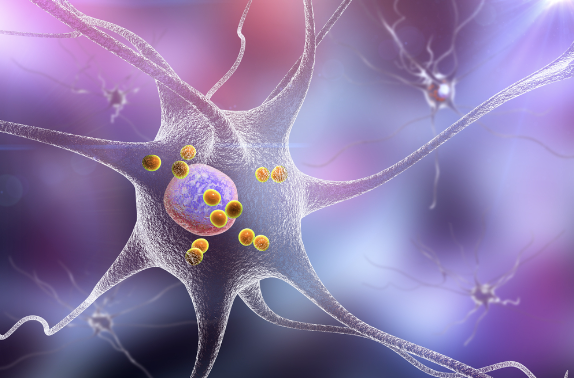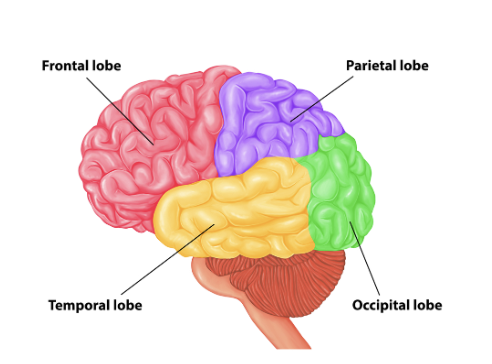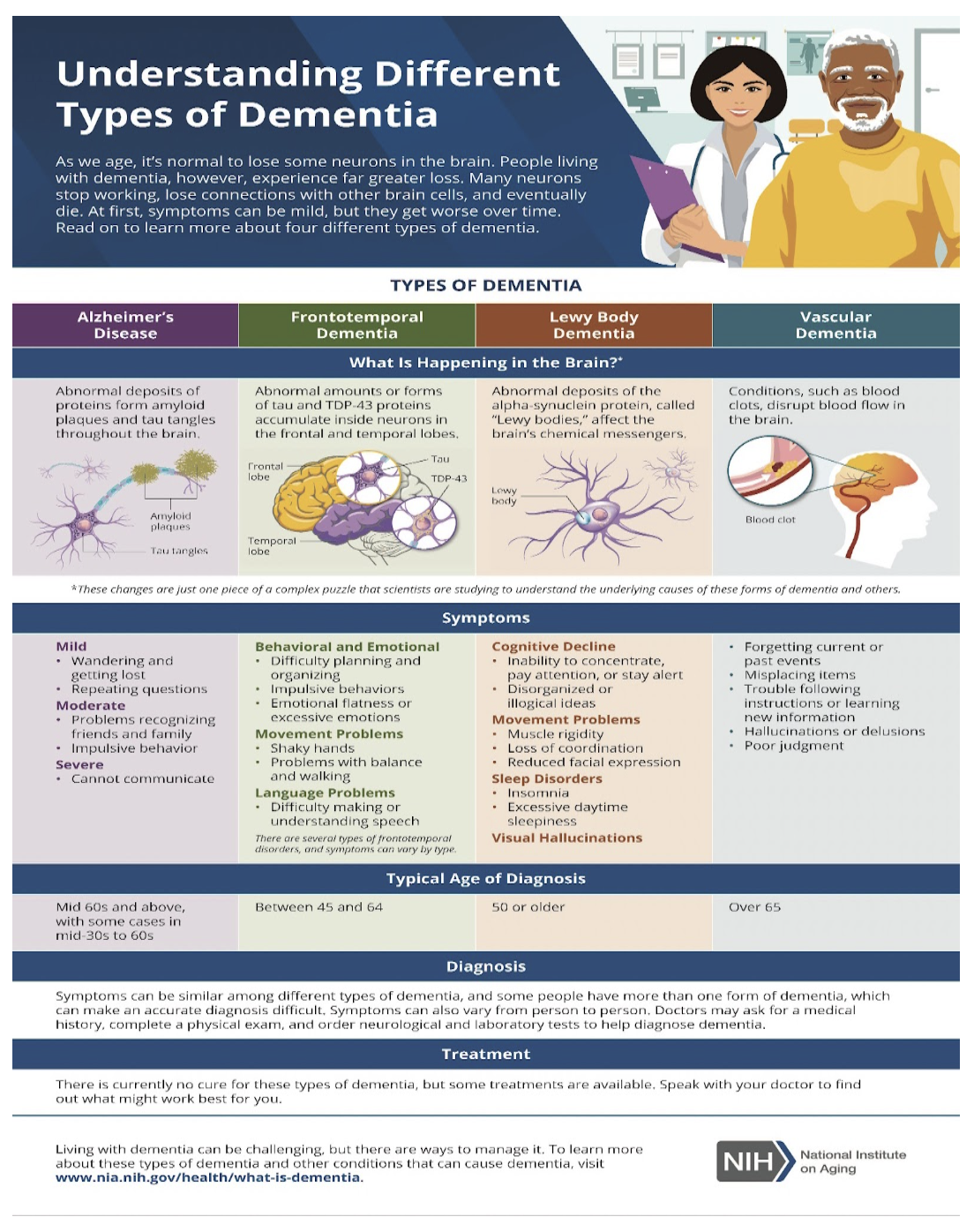Dementia is a broad term that describes a set of symptoms that reflect changes in the brain.
These changes can include loss of memory, language, problem-solving and other thinking abilities that cause interference in daily life. Dementia means more than just forgetting due to getting older.
Over 100 types of dementia have been recognized. Alzheimer’s is the most widely known type of dementia because 60 to 70% of people diagnosed with dementia have Alzheimer’s. Currently there are more than 6 million people in the United States who are living with Alzheimer’s. An easier way to think about it is that two in every three people who exhibit the symptoms of dementia were diagnosed with Alzheimer’s.
However, there are other less known types of dementia to explore. Here are the top four most diagnosed types of dementia besides Alzheimer’s disease: Vascular dementia, Lewy body dementia, Frontotemporal dementia, and Mixed dementia.
It is interesting to note that all of these dementias are caused by the formation of abnormal proteins in the brain, except for vascular dementia.
In order to understand them better, let’s briefly look at the causes and symptoms of each one.
Vascular Dementia
Vascular dementia can be caused by heart disease in the small blood vessels that lie deep inside the brain or by starving the brain of oxygen due to a blood clot. The degree of loss depends on what parts of the brain are affected by a reduced blood flow.
When tiny blood vessels deep in the brain called the subcortex become stiff and twisted due to heart disease, blood does not flow as easily. The parts of the brain served by these blood vessels are slowly starved of oxygen and nutrients. Eventually they may close off and the brain cells die as a result. This causes a person to be slower in processing information. A person may have difficulty controlling or expressing their emotions.

[The red area represents a blood clot blocking a blood vessel and causing a stroke.]
Another form of vascular dementia (stroke-related dementia) is caused when the blood supply to a certain part of the brain abruptly stops due to a blood clot blocking a blood vessel in the brain. This is called a stroke. The clot may have formed in the brain or it may have formed in the heart and then circulation carried it to the brain where it lodged in a blood vessel. A massive stroke occurs when a blood vessel bursts and causes a brain bleed, but this is not common.
Two factors determine the damage a stroke causes: where the clot lodged in the brain and how long the brain was deprived of oxygen. Not everyone who has a stroke develops vascular dementia.
Someone who has had a stroke is more likely to have another one due to the heart problems present, and this makes them more likely to develop dementia. One in five people develops vascular dementia within six months of having a stroke.
Sometimes a person has a series of smaller strokes or transient ischemic attacks (TIAs). They are called transient because the blood clots often dissolve quickly on their own. When this happens the symptoms may only last for a few minutes: a weakness down one side of the body, a drooping side of the face or slurred speech.
Multiple strokes can cause multiple damage in various areas of the brain. The damaged areas of the brain are called infarcts. As the damage builds up, dementia develops and the person experiences problems with memory, planning, and communicating.
According to the American Stroke Association, symptoms may include:
- Memory loss
- Confusion
- Language problems (aphasia)
Difficulty paying attention or following a conversation - Difficulty planning and organizing tasks (cooking a meal)
- Difficulty with calculations, making decisions, solving problems
- Visual orientation problems, hallucinations
- Impaired motor skills
Dementia with Lewy bodies (DLB)— aka Lewy body Dementia (LBD)
This type of dementia is caused by the buildup of abnormal protein deposits in the brain called Lewy bodies. Lewy bodies can be found in several areas of the brain involved with thinking, memory, and movement, and they affect the brain’s chemical messengers. Researchers don’t know why these proteins form or how they cause Lewy body dementia symptoms.
In the diagram below, the small spheres represent Lewy bodies inside a single nerve cell.

[the small spheres represent Lewy bodies inside a single nerve cell.]
The diagnosis of LBD may be difficult because the early symptoms are similar to those of Alzheimer’s disease and dementia due to Parkinson’s disease dementia (PDD).
In Parkinson’s dementia, movement symptoms often come first. In Lewy body dementia, the cognitive and behavior symptoms often come first, followed by movement difficulties later.
One of the unique features of Lewy body dementia is that cognitive abilities can fluctuate from hour to hour or day to day. A person with LBD may be mentally clear one moment and confused and disoriented soon after.
Hallucinations are another symptom of LBD. They can be very vivid and detailed and cause anxiety and agitation for the person experiencing them and for the care partner in trying to soothe or calm the person’s agitation.
The symptoms of LBD can vary from person to person, but some of the early symptoms may include:
- Fluctuations in cognitive abilities (problems with memory, attention and problem-solving)
- Movement problems (including tremors, stiffness, and difficulty with coordination)
- Sleep disturbances (such as insomnia or excessive daytime sleepiness)
- Vivid hallucinations (seeing people or animals inside the house or threatening from outside)
- Sensitivity to antipsychotic medications (can worsen symptoms and increase side effect risk)
Fronto-temporal dementia (FTD)—aka Pick’s Disease
There are two frontal lobes of the brain and two temporal lobes.

The frontal lobes sit behind the forehead above the eyes and are important in executive functioning such as making decisions, planning, sequencing, and prioritizing. They are involved in language (putting words together to form sentences) and in motor abilities (moving the arms, legs, and mouth). They also help manage emotional responses.
The temporal lobes sit below and to the side of each frontal lobe on the left and right sides of the brain. They play important parts in memory, language and emotions. They help people connect words with their meanings, form words into sentences, recognize objects and even relate appropriate emotions to objects and events.
A protein called TDP-43 found in these lobes can undergo abnormal changes. When this happens, a person can lose basic abilities such as thinking, talking, walking, driving, and socializing.
The part of the brain affected first determines which symptoms appear first. (9) The frontal lobe is responsible for decision-making, so if the disease damages it, then decision-making becomes an issue. A person might forget how to manage their finances or the rules for driving safely.
If the disease begins in a temporal lobe, a person might not be able to show facial emotion or read the emotions of others. Social filters and empathy may disappear resulting in the person making hurtful comments, showing no impulse control, and acting out inappropriately in social situations. The negative emotions attached to certain things such as the potential threat of a poisonous snake or a flame burning on a stove may no longer have meaning, leaving the person vulnerable to possible injury.
FTD is rare and affects a younger part of the population between 45 and 64 years old.
According to the Mayo Clinic, some common signs of FTD include:
- Changes in personality — socially withdrawn, apathetic
- Difficulty with language — difficulty finding the right words, speaking in coherent sentences, understanding others
- Impaired executive function — difficulty with multi-tasking, problem-solving, decision-making
- Lack of inhibition — inappropriate social behavior, impulsivity and decreased empathy
- Changes in eating habits — increased cravings for sweets, overeating, or preferences for only certain foods
Mixed Dementia (MD)
Mixed dementia occurs when more than one condition causes someone’s dementia. According to the Alzheimer’s Association, at least one out of every ten people diagnosed with dementia has mixed dementia.
The most common mixed dementia is a combination of Alzheimer’s disease and vascular dementia.
Since many of the symptoms of dementia overlap, it may be difficult to diagnose mixed dementia. However, it is important to find out because of the effects two dementias will have on the brain, and how the person may progress through the disease.
NIH CHART
In summary, here is a chart from the National Institute on Aging that shows the different types of dementia, their symptoms, and the typical age of diagnosis. There is currently no cure for these types of dementia, but some treatments are available.

Sources
Vascular Dementia | American Stroke Association
What Is Lewy Body Dementia? Causes, Symptoms, and Treatments | National Institute on Aging
Frontotemporal dementia – Symptoms and causes – Mayo Clinic
Mixed Dementia | Symptoms & Treatments | alz.org
#typesofdementia #kindsofdementia #dementiasymptoms #alzheimers #vasculardementia #frontotemporaldementia #lewybodydementia #mixeddementia #alzheimershelp #dementiacaregiverhelp #dementiahelp #dementiafamilycaregivers
